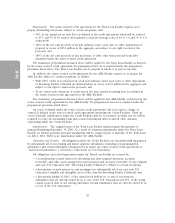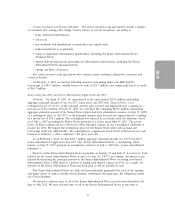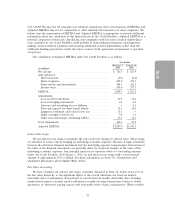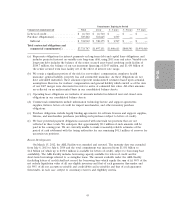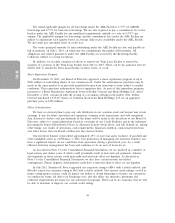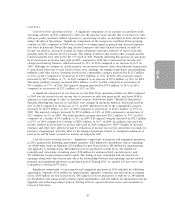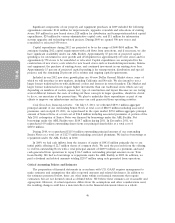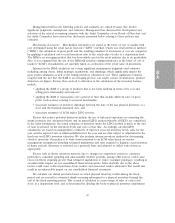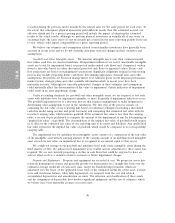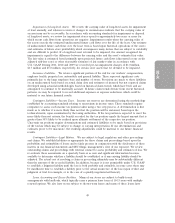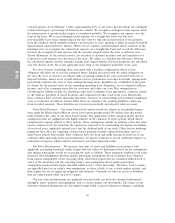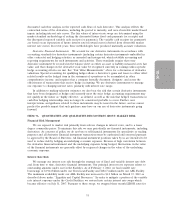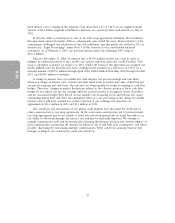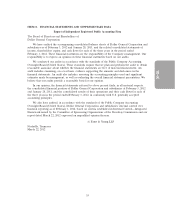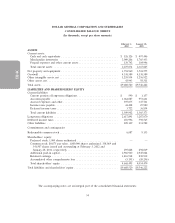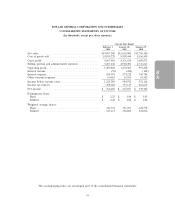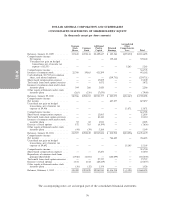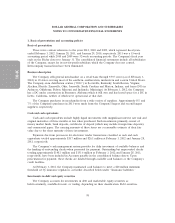Dollar General 2011 Annual Report Download - page 148
Download and view the complete annual report
Please find page 148 of the 2011 Dollar General annual report below. You can navigate through the pages in the report by either clicking on the pages listed below, or by using the keyword search tool below to find specific information within the annual report.
10-K
recorded during the previous twelve months by the related sales for the same period for each store. To
the extent that subsequent physical inventories yield different results than this estimated accrual, our
effective shrink rate for a given reporting period will include the impact of adjusting the estimated
results to the actual results. Although we perform physical inventories in virtually all of our stores on
an annual basis, the same stores do not necessarily get counted in the same reporting periods from year
to year, which could impact comparability in a given reporting period.
We believe our estimates and assumptions related to merchandise inventories have generally been
accurate in recent years and we do not currently anticipate material changes in these estimates and
assumptions.
Goodwill and Other Intangible Assets. We amortize intangible assets over their estimated useful
lives unless such lives are deemed indefinite. If impairment indicators are noted, amortizable intangible
assets are tested for impairment based on projected undiscounted cash flows, and, if impaired, written
down to fair value based on either discounted projected cash flows or appraised values. Future cash
flow projections are based on management’s projections. Significant judgments required in this testing
process may include projecting future cash flows, determining appropriate discount rates and other
assumptions. Projections are based on management’s best estimates given recent financial performance,
market trends, strategic plans and other available information which in recent years have been
materially accurate. Although not currently anticipated, changes in these estimates and assumptions
could materially affect the determination of fair value or impairment. Future indicators of impairment
could result in an asset impairment charge.
Under accounting standards for goodwill and other intangible assets, we are required to test such
assets with indefinite lives for impairment annually, or more frequently if impairment indicators occur.
The goodwill impairment test is a two-step process that requires management to make judgments in
determining what assumptions to use in the calculation. The first step of the process consists of
estimating the fair value of our reporting unit based on valuation techniques (including a discounted
cash flow model using revenue and profit forecasts) and comparing that estimated fair value with the
recorded carrying value, which includes goodwill. If the estimated fair value is less than the carrying
value, a second step is performed to compute the amount of the impairment, if any, by determining an
‘‘implied fair value’’ of goodwill. The determination of the implied fair value of goodwill would require
us to allocate the estimated fair value of our reporting unit to its assets and liabilities. Any unallocated
fair value represents the implied fair value of goodwill, which would be compared to its corresponding
carrying value.
The impairment test for indefinite-lived intangible assets consists of a comparison of the fair value
of the intangible asset with its carrying amount. If the carrying amount of an indefinite-lived intangible
asset exceeds its fair value, an impairment loss is recognized in an amount equal to that excess.
We completed testing on our goodwill and indefinite lived trade name intangible assets during the
third quarter of 2011. No indicators of impairment were evident and no adjustment to these assets was
required. We are not currently projecting a decline in cash flows that could be expected to have an
adverse effect such as a violation of debt covenants or future impairment charges.
Property and Equipment. Property and equipment are recorded at cost. We group our assets into
relatively homogeneous classes and generally provide for depreciation on a straight-line basis over the
estimated average useful life of each asset class, except for leasehold improvements, which are
amortized over the lesser of the applicable lease term or the estimated useful life of the asset. Certain
store and warehouse fixtures, when fully depreciated, are removed from the cost and related
accumulated depreciation and amortization accounts. The valuation and classification of these assets
and the assignment of depreciable lives involves significant judgments and the use of estimates, which
we believe have been materially accurate in recent years.
48


